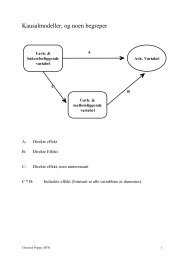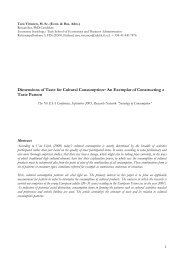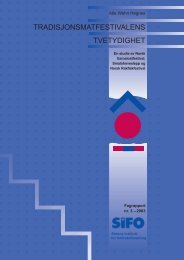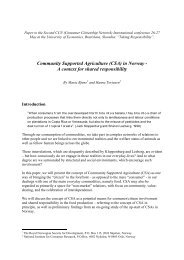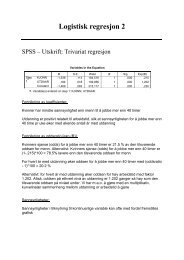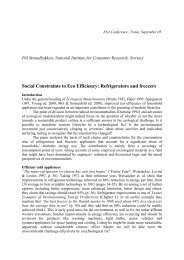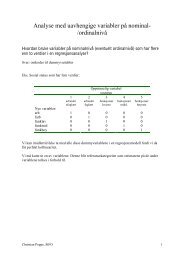Rapport nr - SIFO
Rapport nr - SIFO
Rapport nr - SIFO
- No tags were found...
Create successful ePaper yourself
Turn your PDF publications into a flip-book with our unique Google optimized e-Paper software.
18food sector is very difficult to extend, however, generally due to the fact that the main companies involvedare quite small; incorporating them in an union or organisation is difficult, although it is theonly means to reduce the cost of promotion and to be competitive in this mass market. Individualismand the lack of innovation are the main characteristics of this sector. To develop these small local foodcompanies, owners have to develop networks with other companies to create new organisations fordevelopment and to have a counter-power against the main distribution brands. (Rastoin JL, 2001)Therefore, only companies which are profitable in this sector are innovating companies. Innovationseems to be a bit paradoxical when you mention tradition and old culture for local products, but theinnovation of packaging and especially the sale location will be the foundations for the profitability ofthis type of company.These companies were also successful since they understood that consumer needs are in “contact”with the producers. This underlines and explains why only small companies make local food. It is impossibleto have an international brand making local food for consumers. In some companies likeRaymond Geoffroy with regards to “la brandade de morue de Nîmes” or Marius Bernard “la bouillabaisse”,consumers can directly visit the company and discover how the product is produced. In thisway, it resembles the close proximity which is possible when one can visit production on a farm, forexample.(Rastoin JL, 2001, 1999)Producers are more affected and involved with the process of labelling than transformers or distributors,who generally are not compatible with the policy of CCP, which is more adapted for supply chainthan production.2.3 The Terroir companiesThree main types of manufacturing of local food exist. One type involves manufacturing directly bythe producer, which often lacks labelling since in most cases it involves a direct sale on his/her ownfarm or in a cooperative. This producer may discuss and ensure the product and its quality to the consumer,as opposed to conventional quality-assurance methods represented by the Official Signs ofQuality. Currently, there are more than 120 000 producers who manufacture a PDO or PGI product,which represent approximately 15% of the professional producers in France. However, it is also possiblethat there are a lot of other producers of local food who are not using appellations, making it difficultto know the real number of producers who directly sell on their farm without the Official Signs ofquality.The second type of manufacturing involves organisation within a Union of producers which also managesthe product’s commercialisation (i.e. Roquefort PDO). This organisation with an administrationboard can be a means to counter-balance the power of distributors when the products are not sold bythe producers themselves. It also manages advertisement with a common budget, as well as future orientationsfor the appellation or products.Finally, local companies may also manufacture local food, with local or regional area influence (territorywhere the raw materials are bought). However, these companies may also produce products forstore brands, which explains why some local companies have increased their production capacity sincethe introduction of these store brands.




